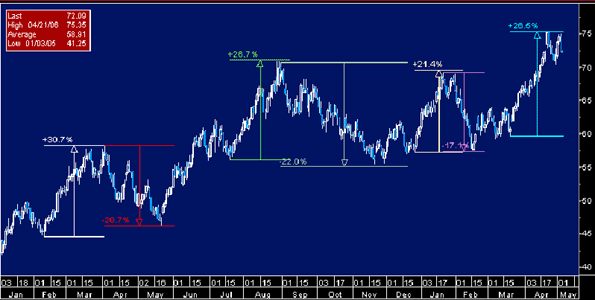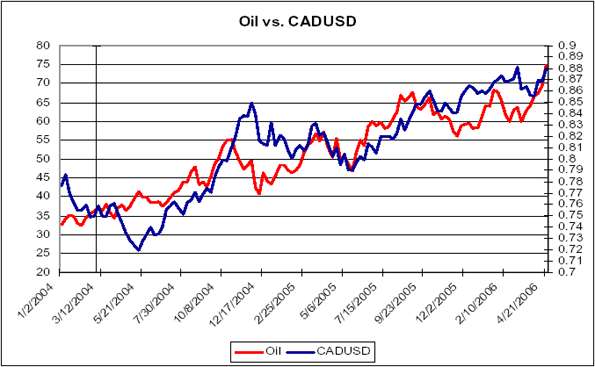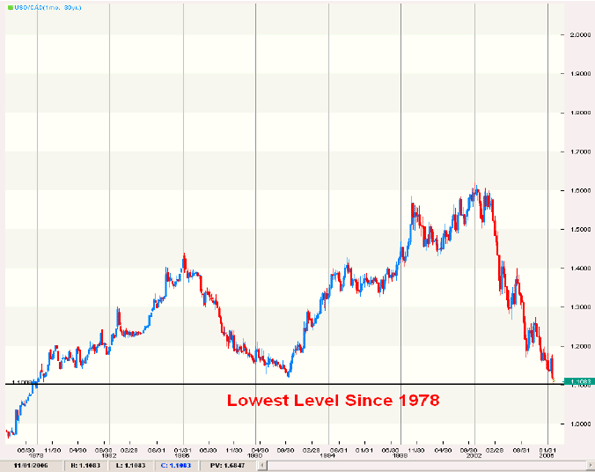Oil prices are on the rise once again and this time crude is setting fresh record highs in the process. In the past month alone, crude prices have increased by a whopping 21 percent, leading many to ask how much longer can this rally continue. The latest round of oil strength stems from Iran's announcement that they have successfully enriched uranium for the very first time. Geopolitical tensions are rising as the oil market fears that the US may respond with an attack on Iran, the holder of the third largest oil reserves in the world. The US does not import any oil from Iran, but many countries such as Russia, China and some European nations do. With prices so high, gas at the pumps has hit $4 /gallon in Beverly Hills while some pumps are going dry at Philadelphia area gas stations. Yet when the mania hits a peak and everyone is screaming that things will only worsen, we may be near a top. Just look back at the hysteria points in August 2005 and February 2006. In both rallies, prices first rose by 26 and 21 percent respectively. At the time, the market became extremely concerned, gasoline prices skyrocketed and unsurprisingly, oil prices tipped over shortly thereafter to erase at least two thirds of the gains before rising once again. Therefore, it is quite likely that we are at same turning point in oil at this moment, especially since prices have already rallied 26 percent. Back in November and December of last year, when we were entering the winter season, the prospects for oil looked the most dismal because energy usage at that time was a necessity. Now in contrast, even though we are moving into the usually busy summer driving season, taking extra road trips with the kids is something that can be avoided.
Retracement Waves in Oil
If history is a reliable barometer, then we expect another retracement "wave" in oil. According to the chart below, each rally wave lasted only 2 months before reversing. We have just begun the second month of the rally, which means that we could see a bit more of an extension, but the additional percentage gain should be limited. However once the move lower occurs, judging from previous retracement moves, we could easily see a $10 drop in crude prices.

USD/CAD: The Trade To Turn To If Oil Crashes
If oil crashes, there will be ripple effects on many economies. In the Middle East, a lot of wealth and home valuations are tied to oil, making it even more important for those traders to look for hedging opportunities. The same is true here in North America. Canada's booming economy has been fueled by the climb in oil which has benefited domestic corporate profitability. It has also sent the Canadian dollar to 28 year highs against the US dollar by boosting the international purchasing power for Canadians. As the world's second largest holder of oil reserves, Canada has been one of the primary beneficiaries, which means that if oil crashes, it will also be the currency that will suffer the most.
In contrast, the US stands to benefit greatly if oil prices slide. For months now, there has been a widespread fear that the rise in oil could weigh heavily on consumer spending. With the housing market bubble already posing a big risk for the economy, the potential impact of skyrocketing oil on spending has been one of the biggest arguments against a prolonged Federal Reserve tightening cycle. The lower the price of oil, the more stimulative it is for the US economy as discretionary income of US consumers increases. Therefore if oil does crash, this fear of an economic slowdown will be greatly alleviated and be taken as a promising sign by dollar bulls. Of course, this may bring up the question that since oil is priced in dollars, why wouldn't the dollar suffer from a decreasing value of oil purchases. The answer is the same answer as why the dollar does not benefit from the higher price of oil. It is because a lot of central banks already have reserves in dollars and the same is true for companies, which means that they do not need to convert additional money into dollars in order to fund new purchases.
This makes the long USD/CAD trade the perfect hedge against falling oil prices. The chart below shows the close correlation between Oil and USD/CAD (inverted in graph). When oil prices rise, USD/CAD falls and vice versa. Since the beginning of 2004, the correlation between these two products has been a strongly negative 86 percent. On top that, sliding oil prices would bring about improvements to the US economy and the prospects for higher US interest rates. For Canada on the other hand, the Canadian economy would suffer and in the extreme scenario, forcing the Bank of Canada to cut short their tightening cycle. In the extreme scenario, they may even opt to reduce interest rates, which would hurt the Canadian dollar significantly. For the time being, the differential between the rates in the US and Canada is 100 basis points, which means that for each day a trader holds one regular lot of USD/CAD on the long side, the trader would earn $2.80 in interest income, a benefit that short oil contracts do not offer. Therefore USD/CAD is a very interesting trade to look into if you think the oil move is overdone and may due for a retracement.

USD/CAD Already Battered
Furthermore, USD/CAD is already trading not far from its 28 year lows, suggesting that support may come in soon enough for the currency pair. It was only four years ago that the dollar was trading at 1.60 against the loonie and we are already showing signs that the sell off may be nearing an end. For three consecutive months, USD/CAD has touched the same lows and failed to break through, making it an even more attractive trade if you need to hedge against a slide in oil. Eventually, as oil continues to rise, the benefits for the Canadian economy will also begin to subside. The market tends to forget that Canada is also a huge net exporter to the US. Therefore the stronger the loonie, the weaker the exports. Canadian automobile exports have already begin to suffer.

Kathy Lien is the Chief Currency Strategist at FXCM.